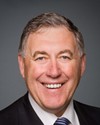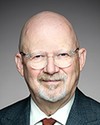Thank you, Mr. Chair and members of the committee.
I appear before you this morning in response to your request to release the video related to the attack of October 22, 2014. We seized this video as evidence from the cellphone recovered from the car driven by Michael Zehaf-Bibeau after he murdered Corporal Cirillo and then stormed the grounds of this Parliament armed with a rifle. Of course, we all know he was killed by our brave RCMP and parliamentary security personnel, including the Sergeant-at-Arms, who actively pursued him inside.
I would also like to update Parliament, and through you, Canadians, on the state of our investigative response to this unprecedented attack on our Parliament.
First, permit me to say clearly that the RCMP is engaged in an active criminal investigation to either establish or refute whether anyone aided, abetted, facilitated, counselled, or conspired with Zehaf-Bibeau to commit the crimes he did.
Let me also say that if Zehaf-Bibeau had not been killed but rather taken into custody, we would have charged him with terrorist offences. The Criminal Code provides the definition for terrorist activity at paragraph 83.01(1)(b). The RCMP believes, on the evidence, that Zehaf-Bibeau was a terrorist.
Anyone who aided him, abetted him, counselled him, facilitated his crimes or conspired with him is also in our view a terrorist and where the evidence exists, we will charge them with terrorist offences.
Not relevant to us or our investigation is what kind of a terrorist Zehaf-Bibeau was, or if he was a particularly intelligent, sophisticated, influential, or personally disciplined terrorist. To us, it all turns on the evidence we collect, which we compare against the statute: what was he doing and why was he doing it?
The RCMP is not, nor should we be, in the habit of publicly discussing evidence or evidence collection during an active investigation. The RCMP asserts and zealously defends its operational independence in the conduct of its affairs. I am departing slightly from that practice in this case, having regard for the enormous public interest attached to this case and this committee's request of me.
To tell you a bit about this video now, and what accounts for the delay between October 2014 and today, I first learned about the video when I was briefed on its discovery during the forensic examination of the cellphone seized from the suspect's vehicle. It was the Sunday following the attack. I directed that a press release be issued that day. My thinking was that announcing the existence of the video would, while we were examining and assessing it, ensure against any subsequent criticism that we were concealing the existence of this evidence.
What followed were dynamic discussions within the RCMP about the evidentiary value and the operational utility of this video. We also had to carefully consider what impact its public release could have not only on this investigation, but also what impact it might have on others. We weighed the video's release against the knowledge that it could serve to further radicalize and ultimately incite more violence.
We considered that the video will be used by terrorist elements and sympathizers to facilitate recruitment, financing, and action. On this point, we remain concerned but frankly speaking, that's not our place. It's not our role. But as one of my officers put it to me, if not us, then who? We have the video, and I think it's a fair question.
This video is plainly evidence; of that there is no question, but just what criminality it is evidence of can only ultimately be decided by a court having jurisdiction to weigh and assess it. We aren't there yet, so we in the RCMP have to ask ourselves how we can maximize its utility and probity at bringing forward a criminal case, if ever we do.
Initially, I was inclined to release the video in its entirety, but I was persuaded by the operational decision-makers in the investigation not to do so. Even today, as I show you the video, I must point out that it is not the entire video. There are in total 18 seconds edited from the beginning and the end of the video: 13 seconds at the beginning and 5 at the end.
I am satisfied that there are reasonable and sound operational reasons for these edits, and you will no doubt want to understand these reasons too. Unfortunately, for the very same reasons that we have edited the video, I cannot explain to you at this point why we have done so.
It is not lost on me either that the government is bringing forward new laws to strengthen the fight against terrorism. The release of this video at this time could be seen as seeking to influence that process. I assure you that I have no such motive. The video speaks for itself. It is what it is.
It is not lost on me either that the government is bringing forward new laws to strengthen the fight against terrorism. The release of this video at this time could be seen as seeking to influence that process. I assure you I have no such motive. The video speaks for itself. It is what it is.
You must understand that I have teams of dedicated professional investigators and specialists working tirelessly to pursue this very case to its conclusion, and it's in everybody's interest to let them do what they do best: investigate.
Through our INSET structure, the RCMP has over 130 full-time investigators and staff presently working on this case. We've interviewed over 400 individuals, from the people he associated with in British Columbia, to the people with whom he rode the Greyhound bus, to the people who saw him at the shelter in Ottawa.
We know now that Zehaf-Bibeau became increasingly aligned with terrorist ideology in the last years of his life while living in the Lower Mainland of British Columbia and for a short period in Alberta.
We know that in August 2014 he applied for a Canadian passport at a Vancouver location, where he was later informed that a passport would not immediately be forthcoming and that his application was subject to further review. Beginning on September 23 and continuing to October 2, Zehaf-Bibeau made his way to Ottawa by hitchhiking and travelling on a Greyhound bus. During at least one leg of the bus trip he told other passengers that his purpose for travelling to Ottawa was to secure a passport.
We now know that within two hours of arriving in Ottawa, Zehaf-Bibeau went to the Libyan embassy to renew his then-expired Libyan passport. He was a dual national. He was told that his application would have to be sent to Libya due to discrepancies in identification documents. This process was expected to take three to four weeks to resolve.
Two days later, on October 4, surveillance cameras on Parliament Hill captured Zehaf-Bibeau on the grounds as he took a guided tour of Centre Block. From our review of the video and speaking to people on the Hill that day, there was nothing remarkable about his participation in that tour that ought to have led either RCMP members deployed on the Hill or other security personnel to be suspicious of his presence.
Throughout his time in Ottawa, Zehaf-Bibeau used publicly available Internet and pay phones in various locations across the city. We now know that he used this as a means to stay in contact with individuals both in the Ottawa region and in British Columbia. We have been able to identify some of these individuals and we continue to pursue this avenue.
We have a full understanding of his finances and the disbursements he made prior to this attack. On the days leading up to October 22, Zehaf-Bibeau made arrangements to buy a car. On October 21 he finalized the deal and used cash to purchase the vehicle. Upon taking possession he drove to Mont Tremblant to visit a relative, where he was seen with a long knife.
Very early the next morning, October 22, he was observed by witnesses placing a rifle in the trunk of his car. Hours later he shot and killed Corporal Cirillo, got back in his car and then stormed Parliament. I've shared with you his approach to this building.
We have not been able to confirm the origins of the gun. We are releasing a photo of the gun, which seems unique, in the hope that someone might recognize it. I can confirm that he had a long knife tied to his wrist when he was killed. We did not find any other guns or weapons in his car, among his possessions, or at any of the other locations we now know he visited in the hours leading up to the attack.
I have been advised that he was shot many, many times, but exactly how many times I can't say because I don't know. We await the detailed findings of the OPP, who were engaged to independently investigate the police-involved shooting inside Parliament. The video from inside this building forms part of that line of inquiry and is with the OPP.
I can confirm that the autopsy toxicology screen on Zehaf-Bibeau's remains was negative for drugs and alcohol. Neither did we uncover any evidence of drug or alcohol used by him in the period leading up to his attack.
It was during the search of his vehicle following the attack that we found Zehaf-Bibeau's mobile phone. Our forensic analysis, which began immediately and progressed quickly, revealed the video.
We have been able to determine with exact precision the time and location where Zehaf-Bibeau made this video. As you will see in a moment, Zehaf-Bibeau filmed himself in his car with the phone immediately prior to the attack at the National War Memorial. We have established that he did this while parked at a lot near 464 Metcalfe Street. He looks directly into the camera, appears very purposeful and lucid, and talks about his motivations for the attack to come.
The audio is not great. It is sufficient, though, to understand what he says. I am providing copies of a transcript in both languages of what he says.




